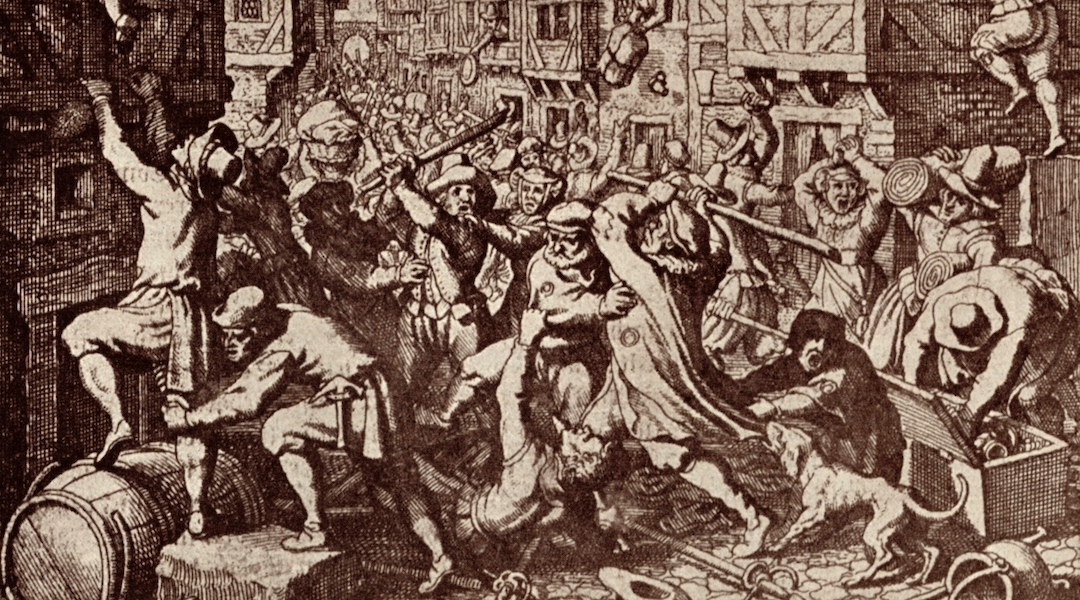This article initially appeared in My Jewish Learning’s Shabbat newsletter Recharge on Feb. 24, 2024. To sign up to receive Recharge each week in your inbox, click here.
(JTA) — About 400 years ago, in the city of Frankfurt, a peculiar historical event took place. At first, it looked like so many other spasms of antisemitism that plagued Europe over the centuries.
In 1612, in the lead up to the election and coronation of the Holy Roman Emperor Matthias, the citizens of Frankfurt were informed that they had to cooperate totally with this new transfer of power or face the loss of certain privileges. Not satisfied that these so-called “privileges” actually existed, protests against various government representatives began. The ringleader was Vincenz Fettmilch, a pastry chef who resented both the authorities and the Jews. As his gang’s list of demands grew, one remained relatively constant: expel the Jewish community from the city.
In 1614, overflowing with anger at the status quo, and fueled by typical antisemitic beliefs, Fettmilch and his gang attacked Frankfurt’s Judengasse, or Jewish ghetto. They looted the neighborhood and expelled the Jews from the city. A known troublemaker, Fettmilch was shortly thereafter arrested, and two years later executed, his home destroyed, his allies banished. On the same day, the Jews were permitted to return to Frankfurt, their rights and citizenship restored.
On the surface, nothing seems too peculiar about this persecution. Antisemitism in Germany in the Middle Ages probably surprises no one. But the sudden reversal and homecoming was. When the uprising was over, the Jews began the process of commemorating the experience. In response to their brief expulsion and restoration, they created an annual holiday on the 20th of Adar called Vinz-Purim, a clever allusion to Vincenz Fettmilch and the familiar Jewish holiday of Purim. Every year, the Jews observe a day of fasting followed by a day of feasting in memory of the events of 1614. The tradition continued in the Frankfurt Jewish community for 200 years.
Declaring a Second Purim (also known as Purim Katan, “Little Purim”) was once a common practice in Jewish communities that had experienced threats of extermination that were suddenly — in true Purim spirit — turned upside-down. Like Frankfurt on Vinz-Purim, those communities established special days of feasting and gift-giving, rejoicing in their unexpected redemption from violence and annihilation.
As it turns out, this week we mark another kind of Purim Katan. This one is not about a historical event, but is connected to the current moment in the Jewish calendar, which follows the lunar cycle and periodically extends the calendar from its typical 12 months to 13 in order to maintain alignment with the seasons. We do this by doubling the happy month of Adar, which also happens to be the month of Purim. In years like this one, we have both a First Adar and a leap Second Adar. While Purim is celebrated on the 14th of Second Adar, the 14th of First Adar is known as Purim Katan. (It falls this year on Feb. 22 and 23.)
During leap years, while we await actual Purim in Second Adar, we have the opportunity to extend the Purim spirit and reflect on ways the Purim story relates to modern history and our contemporary lives. On Purim Katan, many Jews abstain from the sadder Jewish rituals (like saying Tachanun or fasting) and even celebrate a bit.
In contemporary times, Jewish resilience has never been more needed. Where I live in Germany, we not only walk streets loaded with the history of the Holocaust, we also face an unprecedented rise in antisemitism. Creating welcoming Jewish spaces, as we do at my organization, Hillel Deutschland, is essential to fostering resilience within today’s German Jewish communities. We’ve also learned, given our unique circumstances, that resilience need not be something we practice alone. We maintain strong ties with other marginalized groups in Germany that are frequently targeted, sometimes violently. Solidarity with our neighbors has become a key action we can take to maintain a pluralistic, democratic society — a safer space for all of us to live.
So in cultivating a Purim spirit suited for 5784, let us take the energy of medieval Jewish Frankfurt seriously. Even in the face of threat, we must celebrate the good, reminding ourselves how far we’ve come and how robust Jewish tradition is. The choice to extend the Purim spirit speaks volumes about how our people value resilience. Facing near-annihilation or near-expulsion is tragic and undoubtedly traumatic. However, we have learned from our ancestors not to let the horror completely define our memory of these events. Indeed, we have learned to celebrate and rejoice in our redemption. We’re alive. Our tradition is intact. And we’re getting stronger in our identities by the day. So let’s eat!
JTA has documented Jewish history in real-time for over a century. Keep our journalism strong by joining us in supporting independent, award-winning reporting.







